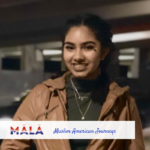Mahreen Ansari: To Be a Pakistani-American in White America
Mahreen reflects on the complicated nature of intersecting identities. In her stories, she remembers formative incidents of prejudice, friendship, and learning as she developed her own identity as a Pakistani American.
The smell of curry and other spices waft through my home and cling to my hair, giving it an ethnic smell that everyone at my school is guaranteed to notice tomorrow. I set the table and wait patiently for my parents to bring out the food. We all eat with our hands, scraping our plates bare and then going back to get seconds. The doorbell rings and my mom goes to get it, I timidly follow her. I cling to her leg as she opens the door to reveal some of our white neighbors. They blatantly pinch their noses and stare at our yellow tinted hands as they complain about our trees dropping fruit into their yard again.
I climb onto the bus on a Monday, still dizzy from the previous weekend of Eid celebrations. My hands are painted with mendhi, a landscape of intricate red and orange designs. “Why do you have marker on your hands?” A little white girl sitting across the aisle asks me. I look at her confused. More heads pop out, examining me head to toe, especially my hands. I begin to try to explain what mendhi is and why we wear it as well as a five year old could, but I was cut off by, “She’s wearing marker on her hands! Oh my God, look at her! She’s so dumb!”
I sit on the edge of a pool bathing in sunlight, just letting my feet hang in the cool water. “Hi!” A white girl exclaims as she swims up to me. “I’m Carol, what’s your name?” I slowly slide down into the water. “I’m Mahreen.” “That’s so funny, my grandma’s name is Mary!” I give her an awkward smile but decide to let it slide, knowing that I’d probably never meet her again. “Where are you from?” She asks me with a giant smile. I give her a confused look and answer, “Here…?” Her smile grows even larger, “Oh! So are you like Indian?” I smile, understanding that the average Dick and Jane doesn’t know Pakistan exists even though it’s been a country since 1947, “Yeah.” “That’s so cool! I’m like 1/8 Indian!” She responds grinning from ear to ear. Feeling intrigued I ask her, “So where in India is your family from?” She laughs, “India? Ohhhhhhhhhhh, you’re one of those red dot Indians who worship cows?”
Growing up in a predominantly white country was difficult for me as a child. Since the day I was born, there has been a struggle between my Pakistani and American identities. My American identity pushes me to do things to fit in more with my peers. While my Pakistani identity caused me to be ostracized at times and an item of curiosity at other, causing me to want to forego that identity completely.
When I was young, I didn’t know how to deal with this struggle and it caused me a great deal of stress. For a time in my life, I was only American as far as I was concerned and did everything I could to fit in. But something happened the summer after my sophomore year that caused a giant paradigm shift. I began to look for a balance between my two identities because they both had an equal right to be a part of my life. I started occasionally wearing shalwar kameezs to school, relearning Urdu, and being an unapologetic Pakistani-American. I found my own way of allowing my two worlds to coexist without one overshadowing the other.


